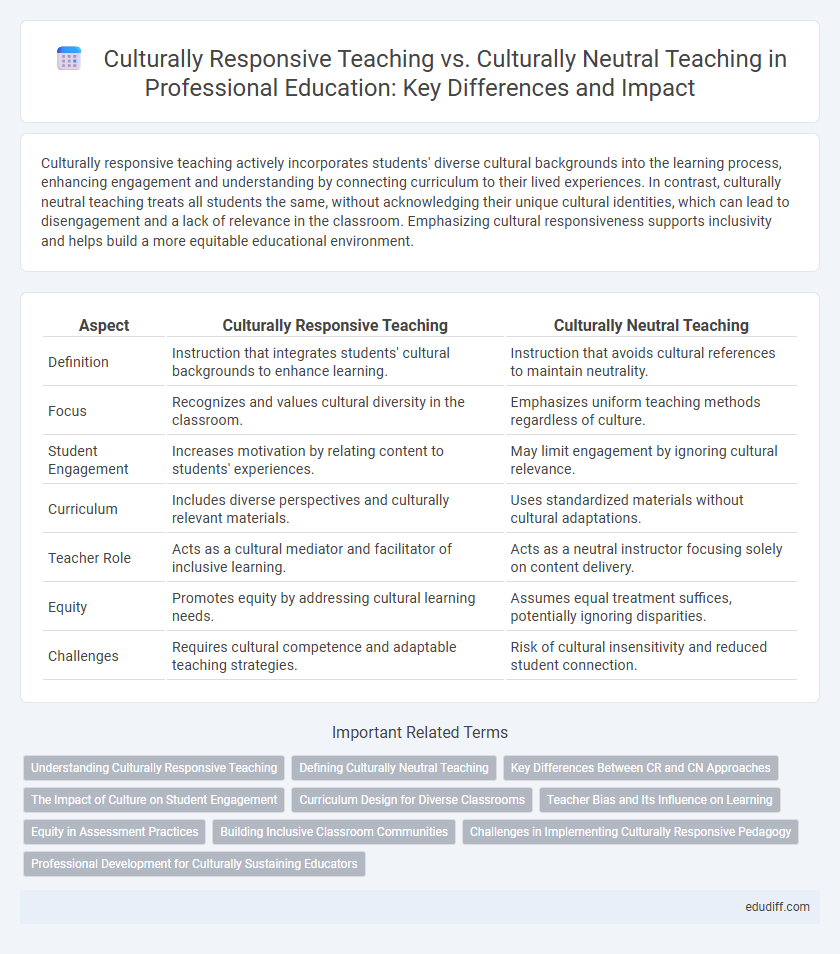Culturally responsive teaching actively incorporates students' diverse cultural backgrounds into the learning process, enhancing engagement and understanding by connecting curriculum to their lived experiences. In contrast, culturally neutral teaching treats all students the same, without acknowledging their unique cultural identities, which can lead to disengagement and a lack of relevance in the classroom. Emphasizing cultural responsiveness supports inclusivity and helps build a more equitable educational environment.
Table of Comparison
| Aspect | Culturally Responsive Teaching | Culturally Neutral Teaching |
|---|---|---|
| Definition | Instruction that integrates students' cultural backgrounds to enhance learning. | Instruction that avoids cultural references to maintain neutrality. |
| Focus | Recognizes and values cultural diversity in the classroom. | Emphasizes uniform teaching methods regardless of culture. |
| Student Engagement | Increases motivation by relating content to students' experiences. | May limit engagement by ignoring cultural relevance. |
| Curriculum | Includes diverse perspectives and culturally relevant materials. | Uses standardized materials without cultural adaptations. |
| Teacher Role | Acts as a cultural mediator and facilitator of inclusive learning. | Acts as a neutral instructor focusing solely on content delivery. |
| Equity | Promotes equity by addressing cultural learning needs. | Assumes equal treatment suffices, potentially ignoring disparities. |
| Challenges | Requires cultural competence and adaptable teaching strategies. | Risk of cultural insensitivity and reduced student connection. |
Understanding Culturally Responsive Teaching
Culturally responsive teaching emphasizes the integration of students' cultural backgrounds into the curriculum to enhance engagement and learning outcomes. It recognizes diverse cultural perspectives as valuable assets, fostering an inclusive classroom environment that supports identity affirmation and academic success. Research indicates that culturally responsive strategies improve student motivation and achievement by aligning instructional methods with cultural contexts.
Defining Culturally Neutral Teaching
Culturally neutral teaching emphasizes an approach that avoids incorporating specific cultural references, aiming to create a standardized learning environment perceived as unbiased. This method treats all students the same, often disregarding their unique cultural backgrounds and experiences. However, it can inadvertently overlook the diverse needs and perspectives essential for inclusive education and effective student engagement.
Key Differences Between CR and CN Approaches
Culturally Responsive Teaching (CRT) integrates students' cultural backgrounds into the curriculum to enhance engagement and learning outcomes, emphasizing inclusivity and relevance. In contrast, Culturally Neutral Teaching (CNT) maintains a standardized curriculum without addressing cultural diversity, potentially overlooking students' unique cultural contexts. CRT promotes critical thinking and identity affirmation, while CNT often prioritizes uniformity and neutrality over cultural responsiveness.
The Impact of Culture on Student Engagement
Culturally responsive teaching enhances student engagement by integrating students' cultural backgrounds into the curriculum, promoting relevance and validation of their identities. In contrast, culturally neutral teaching often overlooks the diverse cultural experiences of students, leading to decreased motivation and participation. Research shows that culturally responsive strategies increase cognitive engagement and foster a sense of belonging, which are critical for academic success.
Curriculum Design for Diverse Classrooms
Culturally responsive teaching integrates students' cultural backgrounds into curriculum design, enhancing engagement and academic achievement in diverse classrooms. Curriculum frameworks emphasize culturally relevant content, linguistic diversity, and inclusive pedagogical strategies to foster equity and validate students' identities. In contrast, culturally neutral teaching often overlooks cultural context, potentially marginalizing minority students and limiting the curriculum's relevance to a heterogeneous student population.
Teacher Bias and Its Influence on Learning
Teacher bias in culturally responsive teaching actively acknowledges and addresses students' diverse cultural backgrounds, fostering an inclusive learning environment that enhances engagement and academic success. In contrast, culturally neutral teaching often overlooks these cultural influences, potentially perpetuating implicit biases that hinder equitable learning outcomes. Recognizing and mitigating teacher bias through culturally responsive practices is essential for promoting fairness and improving student achievement across diverse populations.
Equity in Assessment Practices
Culturally responsive teaching enhances equity in assessment by integrating students' diverse cultural backgrounds into evaluation methods, ensuring fair representation of all learners' abilities. In contrast, culturally neutral teaching applies uniform assessment criteria that may overlook cultural nuances, potentially perpetuating achievement gaps. Emphasizing culturally responsive assessment practices promotes inclusivity and accuracy in measuring student performance across diverse populations.
Building Inclusive Classroom Communities
Culturally responsive teaching actively integrates students' diverse cultural backgrounds into the curriculum, fostering a sense of belonging and engagement that promotes inclusive classroom communities. In contrast, culturally neutral teaching often overlooks the unique cultural identities of students, which can inadvertently perpetuate disengagement and cultural bias. Emphasizing culturally responsive pedagogy enhances student participation, reduces achievement gaps, and cultivates respect and understanding among diverse learners.
Challenges in Implementing Culturally Responsive Pedagogy
Implementing culturally responsive pedagogy presents challenges such as addressing diverse cultural backgrounds within a uniformly designed curriculum and overcoming educators' limited cultural competence. Resistance may arise from standardized testing systems that favor culturally neutral approaches, restricting flexibility in teaching methods. Professional development focused on cultural awareness and inclusive practices is essential to navigate these complexities effectively.
Professional Development for Culturally Sustaining Educators
Professional development for culturally sustaining educators emphasizes the integration of culturally responsive teaching strategies that recognize and honor students' diverse backgrounds, promoting equity and inclusion in the classroom. Unlike culturally neutral teaching, which often overlooks the cultural identities of students, culturally responsive approaches actively incorporate students' cultures into curriculum design and instructional practices to enhance engagement and academic achievement. Effective training programs focus on developing educators' cultural competence, critical self-reflection, and adaptive pedagogical skills to support diverse learners meaningfully.
Culturally Responsive Teaching vs Culturally Neutral Teaching Infographic

 edudiff.com
edudiff.com